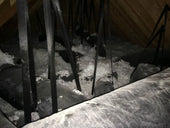Mastic Failure Analysis and Solutions
Introduction
When you hear the word 'mastic', what springs to mind? Maybe it's that gooey substance that keeps things stuck together, or perhaps it's just a word that floats in the DIY sphere. But let me tell you, mastic is more than just an adhesive; it's the unsung hero of construction projects, keeping the integrity of structures intact and preventing the elements from having their way. Yet, what happens when this hero shows signs of weakness? We call it mastic failure, and it's no small matter in the building world. Addressing mastic failure is like finding a leak in your boat mid-voyage; it’s crucial to patch it up before the whole thing comes apart.
Common Causes of Mastic Failure
Mastic failure is a sticky situation, quite literally, but what causes this sticky substance to give up the ghost? Let's delve into the usual suspects:
Environmental Factors
Temperature Fluctuations
You know how we brits love to talk about the weather? Well, mastic does too, but it's not always a fan. Extreme cold can make it brittle, while heat can turn it into a gooey mess. It's like Goldilocks and her porridge – mastic prefers it just right.
UV Exposure
The sun’s rays are like that overzealous friend who doesn't know when to stop; they can be relentless. Prolonged UV exposure can degrade mastic, causing it to lose its elasticity – a bit like how our skin feels after a day at the beach without sunscreen.
Moisture
Water, water, everywhere, and all the boards did shrink. Moisture is mastic’s arch-nemesis, leading to a loss of adhesion and potentially allowing water ingress – a fancy term for leaks that can cause a whole host of issues.
Improper Application
It's not just the weather that can wreak havoc on mastic; human error plays its part too.
Inadequate Surface Preparation
One can't simply slap mastic onto a surface and call it a day. Surfaces need to be as clean as a whistle - free from dust, grease, and old mastic - for the new mastic to adhere properly.
Incorrect Mixing Ratios
Mixing mastic isn't a "roughly about" kind of job. It requires precision, like baking a Victoria sponge. Get the mix wrong, and you're left with a crumbling mess instead of a sturdy seal.
Over-application or Under-application
Too much mastic can be as problematic as too little. It's about finding that sweet spot. Apply too much and it won't cure properly; too little and it won't fill the gap it's supposed to seal.
Types of Mastic Failure
Mastic failure comes in different shapes and forms, each with its tell-tale signs.
Adhesion Failure
This is when mastic says, "I'm just not that into you" to the surface it's meant to stick to. The result? Peeling and detachment – not exactly what you want from a sealant.
Cohesion Failure
Here, the mastic loses its inner strength and splits under pressure. Imagine pulling apart a piece of toffee; that's cohesion failure for you.
Chemical Failure
Sometimes, chemical reactions can occur if mastic meets substances it's incompatible with. It's like when you mix vinegar and baking soda - exciting in a volcano science project, but not so much in construction.
Environmental Failure
When the elements have their way with mastic, it can lead to environmental failure. Think of it as a warrior succumbing to the forces of nature.
Impact of Mastic Failure
The consequences of mastic failure can range from merely cosmetic to downright dangerous.
Structural Integrity
Mastic plays a vital role in keeping structures watertight and airtight. Its failure can lead to water damage, corrosion, and eventually, structural issues. It's the equivalent of a chink in a knight's armour.
Aesthetic Appearance
A failed mastic can lead to unsightly stains, cracks, and gaps. It's like a glaring typo in an otherwise perfect document – it sticks out like a sore thumb.
Safety Hazards
In the worst-case scenario, mastic failure can create safety risks. Loose panels, falling glass, and tripping hazards are just a few of the potential dangers. It's a bit like leaving banana peels all over a Mario Kart track.
Methods for Assessing Mastic Failure
Like a doctor diagnosing an ailment, there are ways to assess the health of mastic.
Visual Inspection
First up, the good old eyeball test. Cracks, peeling, or discolouration? These are visual clues that all is not well in the world of mastic.
Adhesion Tests
These tests are a bit like a tug-of-war between mastic and the surface it's applied to. They measure how well the mastic is holding on for dear life.
Cohesion Tests
Here, we're testing the mastic’s internal fortitude. It's like seeing how much weight a rope can hold before it snaps.
Laboratory Analysis
Sometimes, you've got to take things to the lab. Chemical composition, elasticity, and other properties can be scrutinised to pinpoint the cause of failure. It’s the CSI of the construction world.
Prevention of Mastic Failure
Prevention is better than cure, and that holds true for mastic failure as well.
Proper Surface Preparation
Ensuring the surface is as clean as a new pin and free from contaminants is the first step towards mastic success.
Correct Application Techniques
Mixing and Application Temperatures
Mastic is a bit Goldilocks – it likes the temperature 'just right' for mixing and application. Not too hot, not too cold, but just right.
Application Tools and Methods
Using the right tools and applying the mastic correctly is as important as using the right ingredients in a cake. You wouldn't use a hammer to whisk eggs, would you?
Use of High-Quality Mastic Products
Investing in quality mastic is like choosing a reliable car. It might cost more upfront, but it'll save you from headaches down the road.
Regular Maintenance and Inspections
Regular check-ups can catch issues early, just like visiting the dentist. It's about nipping potential problems in the bud.
Remedies for Mastic Failure
Should you encounter mastic failure, fear not; there are ways to fix it.
Surface Preparation for Repair
Before applying a new mastic, the surface needs a makeover. Clean it up, smooth it out, and make sure it's ready for its new partner.
Removal of Failed Mastic
Out with the old, in with the new. Failed mastic needs to be removed completely – think of it as clearing the weeds before planting new flowers.
Selection of Appropriate Replacement Mastic
Not all mastics are created equal. Choose the right one for the job at hand, like picking the right tool for the right job.
Correct Application of Replacement Mastic
Apply the new mastic with care and precision. It's like icing a cake; do it right, and you'll have a masterpiece. Do it wrong, and well, you've seen those baking fail shows, right?
Post-repair Inspections and Maintenance
After the repair, keep an eye on the mastic as it cures and settles. It's like babysitting – you've got to make sure everything's alright while it's still fresh.
Sustainable Solutions for Mastic Failure
In today’s world, we've got to think about the environment, even when it comes to mastic.
Use of Eco-friendly Mastic Products
Eco-friendly mastics are like the hybrid cars of sealants – they do the job with less environmental impact. Consider using products that are kinder to our planet; after all, it's the only one we've got.
Long-term Performance Considerations
When choosing mastic, think long-term. It's like investing in good quality boots; you want them to last and keep your feet dry, year after year.
Impact of Mastic Failure on Environmental Sustainability
Mastic failure can lead to increased energy consumption and waste – it's like leaving the tap running while you brush your teeth. We can do better by choosing products that last longer and perform better under environmental stress.
Case Studies
Nothing speaks louder than real-life examples. Let's look at how others have successfully managed mastic failure and what lessons we can learn from their experiences.
Lessons Learned from Mastic Failure Experiences
Ever heard the saying, "Experience is the best teacher"? Well, in the world of construction, this rings especially true. By studying the missteps and triumphs of others, we can sidestep potential pitfalls ourselves. When mastic fails, it's like the universe is giving us homework; it’s our job to figure out where things went awry and ensure history doesn't repeat itself.
Best Practices for Mastic Application and Maintenance
It's not rocket science, but there is a method to the mastic madness. The best practices include:
- Reading and following the manufacturer's instructions (they're there for a reason, not just for decoration).
- Regular inspections, like an MOT for your building, to catch any early signs of wear and tear.
- Maintenance, because even the best mastic needs a little TLC to keep performing at its peak.
Table: Best Practices Checklist
| Practice | Description | |-----------------------|-----------------------------------------------| | Follow Instructions | Adhere to product guidelines for optimal use. | | Regular Inspections | Schedule routine checks for early detection. | | Maintenance | Perform upkeep to prolong the mastic’s life. |
Conclusion
As we wrap up our mastic odyssey, let's not forget the key takeaways. Mastic may just be a cog in the construction machine, but it's a crucial one. From the causes and impacts of mastic failure to the methods of assessment, prevention, and remedies, we've covered the gamut. Sustainable solutions are not just a nice-to-have but a must in today's world, and our case studies have shown that with the right approach, mastic failure is not a foregone conclusion but a problem with a solution.
Mastic management might not be the most glamorous part of construction, but it's essential. It's like the bassline of a great song – you might not always notice it, but you'd definitely miss it if it were gone. So here's to mastic, the unsung hero of the construction world – may it stick around, quite literally, for all our sakes.
Remember, proactive mastic management is not just about fixing problems; it’s about setting the stage for a structure that stands tall and proud, come rain or shine. It’s about peace of mind, knowing that the glue that holds everything together is up to snuff. And isn't that something worth aiming for?
So, whether you're a seasoned builder or a DIY enthusiast, give mastic the attention it deserves. After all, the integrity of your project – and your peace of mind – just might depend on it.






























































